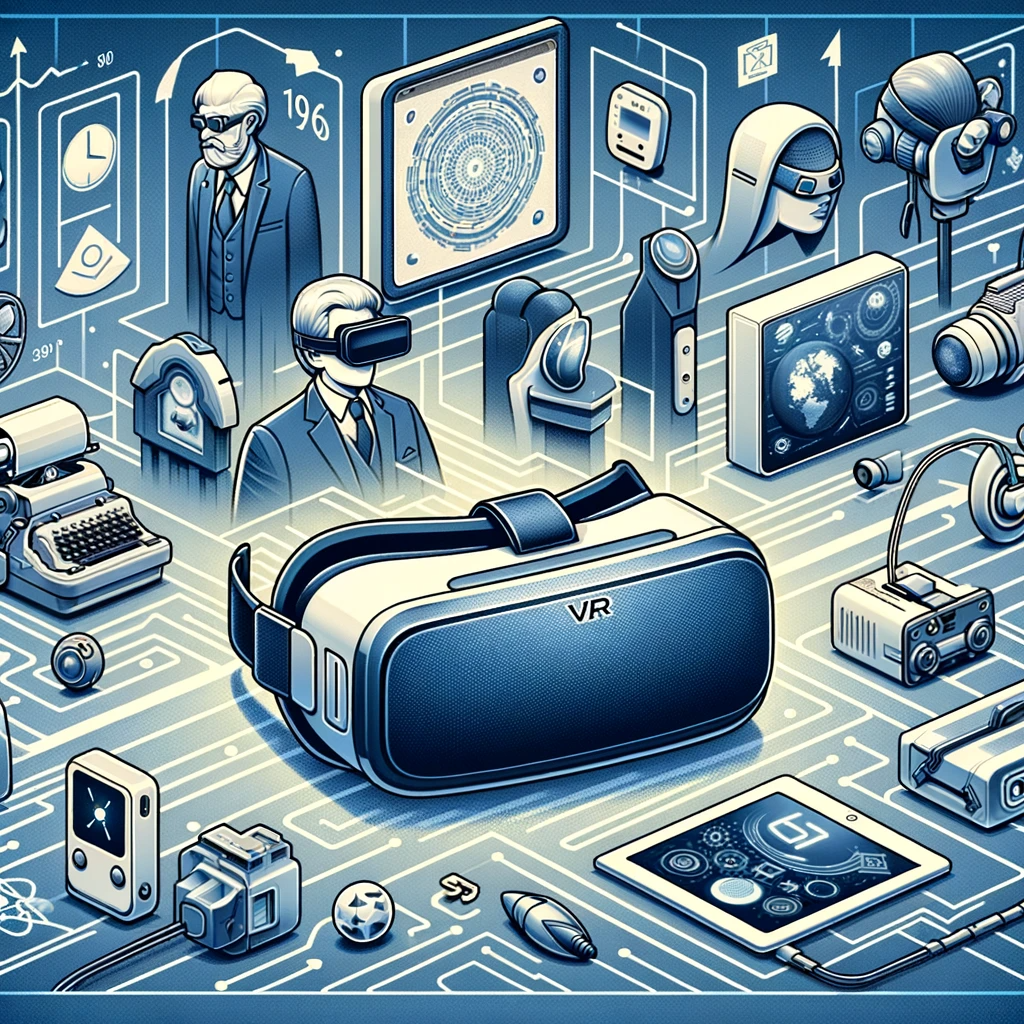Some links on this post may link to affiliate pages that offer compensation to the author of this post.
Unreal Engine 4 has been all the rage across gave development circles with articles like “How to use Unreal Engine 4 for VR Development” gathering a lot of traction. But in todays article, I wanted to touch on how Unreal Engine 4 could substantially change the future of VR development. So we are going to go deep with a full history of VR development, what makes VR development so difficult and why Unreal Engine 4 could alleviate some of these issues.

The History of VR Development
The history of virtual reality (VR) is a fascinating journey that spans several decades, marked by significant milestones and technological advancements. Let’s delve into this history to understand how VR has evolved to its current state.
The VR Development Timeline
In the 1930s, science fiction writer Stanley G. Weinbaum introduced the idea of a pair of goggles that allowed wearers to experience a fictional world through various senses in his story “Pygmalion’s Spectacles.” This concept was remarkably similar to modern VR experiences and highlights the early imaginative roots of VR.
Development of the Sensorama
The 1950s saw Morton Heilig, a cinematographer, develop the Sensorama, an arcade-style theatre cabinet designed to stimulate all senses, not just sight and sound. It featured stereo speakers, a stereoscopic 3D display, fans, smell generators, and a vibrating chair, aiming to fully immerse the individual in the film.
Head Mounted Displays and Motion Tracking
Heilig’s next invention, the Telesphere Mask in 1960, was the first head-mounted display (HMD), providing stereoscopic 3D and wide vision with stereo sound. Although it didn’t include motion tracking, it was a significant step towards immersive visual experiences.
In 1961, the Headsight, developed by two Philco Corporation engineers, featured a motion tracking system and was one of the first precursors to the modern HMD. It was designed for immersive remote viewing of dangerous situations by the military.
The Ultimate Display and The Sword of Damocles
Ivan Sutherland, in 1965, described the “Ultimate Display” concept, which could simulate reality so convincingly that it was indistinguishable from actual reality. This concept laid the groundwork for what VR aims to achieve today.
1968 was a pivotal year with the creation of the first VR/AR head-mounted display, the Sword of Damocles, by Ivan Sutherland and his student Bob Sproull. Although primitive and unwieldy, it was a landmark in VR technology.
The First AR Experience and Interactive VR Systems
Following this, in the late 1960s and early 1970s, Myron Krueger developed “artificial reality” experiences and the first interactive VR system, VIDEOPLACE, which used computer graphics, projectors, video cameras, and screens without the need for goggles or gloves.
The late 1980s saw Jaron Lanier popularize the term “Virtual Reality.” He founded VPL Research, the first company to sell VR goggles and gloves. Lanier’s work significantly contributed to the development of VR technology and its terminology.
VR Enters the Public Domain
By the early 1990s, VR technology began to find its way into the public domain, with companies like the Virtuality Group launching VR arcade games and machines. These developments marked the beginning of VR’s transition from a scientific and military tool to a form of entertainment and public engagement.
The history of VR reflects a blend of scientific innovation, creative imagination, and technological advancement. From its early conceptualizations in science fiction to the development of immersive, interactive technologies, VR has continually pushed the boundaries of how we experience and interact with digital environments.

The Problem with VR Development
Developing games for Virtual Reality (VR) presents unique challenges that set it apart from traditional game development. These challenges impact various aspects of the development process, from conceptualization to final execution.
One significant challenge is the hardware limitations of VR devices. While technology has advanced significantly, current VR headsets still have constraints, such as being relatively heavy and uncomfortable for extended use. Additionally, the resolution and display quality may not match traditional gaming displays, posing a challenge for developers aiming to create highly immersive experiences. VR technology is also relatively expensive, which limits the audience size and impacts the potential revenue generation from VR games.
Designing for VR is another major hurdle. VR requires a completely different approach to game design because players are fully immersed in the game world. Issues such as motion sickness and player comfort need to be carefully considered. Traditional game controls may not be appropriate or effective in VR environments, necessitating creative and innovative design solutions for player interaction and game controls.
Despite these challenges, VR game development offers substantial opportunities. The medium allows for immersive experiences that are both entertaining and emotionally impactful. VR provides a unique way for players to feel connected to the game world and its characters, paving the way for new storytelling and game design possibilities. Additionally, VR opens up opportunities for new business models, including the potential for hardware sales, subscriptions, and in-game purchases.
Furthermore, VR paves the way for new types of games, especially in social and educational contexts. Social VR games can create virtual spaces for interaction, offering new experiences like virtual reality parties. Educational and training VR games can simulate real-world scenarios in safe environments, allowing for practical learning and skill development.
However, VR game development is not just about overcoming technical and design challenges. It also involves addressing the limited user base due to the high costs of VR hardware. This limitation impacts the budget for game development and the potential for return on investment. Moreover, there is still skepticism from investors, who often view VR as a temporary trend rather than a sustainable market. This skepticism can be a significant barrier to securing funding and support for VR game development projects.
Security concerns also pose a challenge. The cybersecurity aspects of VR are not yet fully explored, and any security breach can have a substantial negative impact on the industry. Additionally, after long sessions of VR gaming, some players report experiencing physical discomfort, such as dizziness and headaches, which needs to be researched and addressed to ensure the safety and comfort of players.

Unreal Engine 4 Features for VR Dev’s
Unreal Engine offers several features that can ease the challenges of VR game development:
- Optimized Lighting and Shadows: Unreal Engine allows for the use of baked lighting instead of dynamic, optimizing shadow quality settings to balance aesthetics and performance, which is crucial in VR where resource management is key.
- Advanced VR Features Integration: The engine supports cutting-edge VR features like hand tracking, spatial audio, gesture recognition, eye tracking, and haptic feedback. These features enhance the immersion and interactivity of VR experiences.
- Realistic VR Environments: Unreal Engine enables the creation of realistic VR environments through high-quality textures and materials, detailed environmental modeling, dynamic lighting and shadows, physics-based interactions, and environmental sound design.
- VR Audio Implementation: The engine provides robust tools for implementing spatial audio, configuring audio assets, reactive sound design, and accurate 3D audio positioning, which are crucial for creating an immersive audio experience in VR.
- Blueprints for VR Interactivity: Unreal Engine’s Blueprints allow for scripting complex behaviors and interactions in VR without extensive coding. This feature is particularly useful for setting up interactive objects and creating custom VR controls.
These features make Unreal Engine a powerful tool for VR game development, offering both performance optimization and creative possibilities to enhance the VR experience.
Thanks for reading to the end of this post. If you find the information I provide to be helpful, please consider subscribing.
Disclaimer: None of the information presented on this site constitutes legal, business, tax, or medical advice. In each scenario, it’s recommended to first chat with a medical, legal, business, or tax professional before making any decisions.


